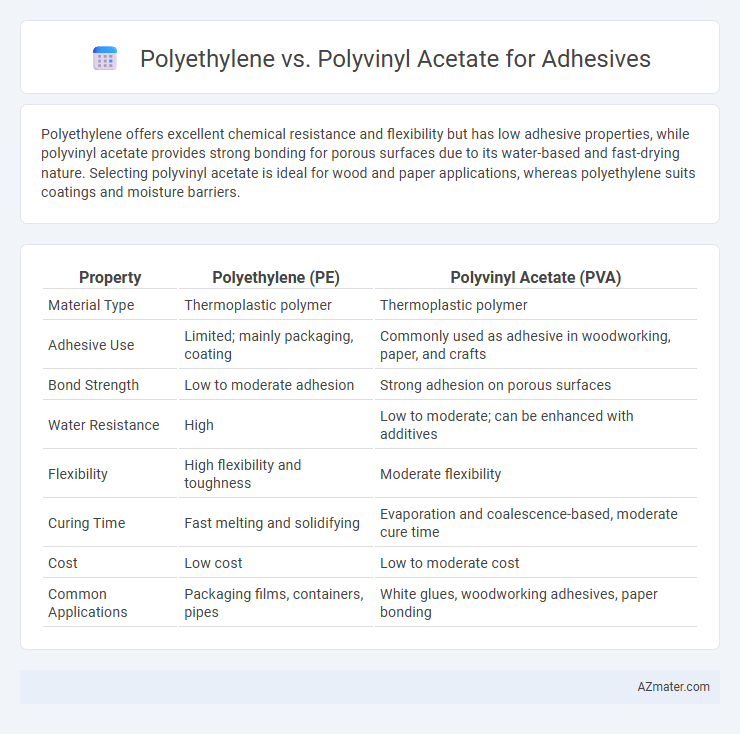Polyethylene offers excellent chemical resistance and flexibility but has low adhesive properties, while polyvinyl acetate provides strong bonding for porous surfaces due to its water-based and fast-drying nature. Selecting polyvinyl acetate is ideal for wood and paper applications, whereas polyethylene suits coatings and moisture barriers.
Table of Comparison
| Property | Polyethylene (PE) | Polyvinyl Acetate (PVA) |
|---|---|---|
| Material Type | Thermoplastic polymer | Thermoplastic polymer |
| Adhesive Use | Limited; mainly packaging, coating | Commonly used as adhesive in woodworking, paper, and crafts |
| Bond Strength | Low to moderate adhesion | Strong adhesion on porous surfaces |
| Water Resistance | High | Low to moderate; can be enhanced with additives |
| Flexibility | High flexibility and toughness | Moderate flexibility |
| Curing Time | Fast melting and solidifying | Evaporation and coalescence-based, moderate cure time |
| Cost | Low cost | Low to moderate cost |
| Common Applications | Packaging films, containers, pipes | White glues, woodworking adhesives, paper bonding |
Introduction to Polyethylene and Polyvinyl Acetate
Polyethylene is a widely used thermoplastic polymer known for its high chemical resistance, flexibility, and durability, making it suitable for various adhesive applications requiring water and solvent resistance. Polyvinyl acetate (PVA) is a synthetic polymer primarily recognized for its strong adhesive properties, excellent film formation, and quick drying time, commonly used in woodworking, paper bonding, and packaging industries. Understanding the molecular structure and bonding characteristics of polyethylene and polyvinyl acetate helps guide their selection for specific adhesive needs.
Chemical Structure Comparison
Polyethylene consists of long chains of repeating ethylene units (-CH2-CH2-) forming a non-polar, hydrophobic polymer with strong C-C and C-H bonds, which contributes to its chemical resistance but limits adhesive properties. In contrast, Polyvinyl Acetate (PVAc) contains vinyl acetate monomers with polar acetate groups (-O-C(=O)-CH3) attached to the polymer backbone, enhancing its polarity and ability to form hydrogen bonds, resulting in superior adhesion to various substrates. The key chemical structural difference is the presence of acetate functional groups in PVAc, making it more suitable for adhesives compared to the chemically inert polyethylene.
Physical Properties Overview
Polyethylene exhibits excellent flexibility, water resistance, and chemical inertness, making it ideal for adhesives requiring durability and moisture protection. Polyvinyl acetate offers strong adhesion with moderate flexibility and is highly compatible with porous substrates like wood and paper. Both polymers differ in thermal resistance; polyethylene withstands higher temperatures, while polyvinyl acetate provides better tackiness at room temperature for bonding applications.
Adhesive Performance and Bond Strength
Polyvinyl acetate (PVA) adhesives exhibit superior bond strength and faster curing times compared to polyethylene-based adhesives, making them highly effective for woodworking and paper bonding applications. Polyethylene adhesives, while offering excellent flexibility and moisture resistance, typically have lower adhesive performance on porous surfaces due to weaker chemical interactions. The choice between these materials depends on the specific application requirements, with PVA favored for strong, permanent bonds and polyethylene preferred for flexible, water-resistant seals.
Application Suitability in Adhesives
Polyethylene offers excellent water resistance and flexibility, making it suitable for adhesive applications requiring durability under moisture exposure and stress. Polyvinyl acetate provides superior adhesion to porous materials such as wood and paper, favoring its use in woodworking and paper bonding applications. Choosing between polyethylene and polyvinyl acetate depends on substrate type and environmental conditions for optimal adhesive performance.
Durability and Environmental Resistance
Polyethylene adhesives offer superior durability and excellent resistance to moisture, chemicals, and UV exposure, making them ideal for outdoor and industrial applications. Polyvinyl acetate adhesives provide moderate durability with good adhesion to porous surfaces but are less resistant to water and environmental factors, limiting their use primarily to indoor projects. Selecting polyethylene over polyvinyl acetate enhances long-term performance in harsh conditions due to its robust environmental resistance and mechanical strength.
Ease of Processing and Application Methods
Polyethylene adhesives typically offer superior ease of processing due to their thermoplastic nature, allowing for melting and remolding without chemical curing. Polyvinyl acetate (PVA), being a thermosetting polymer, requires drying and curing times which can complicate application but provides strong initial tack and bonding on porous substrates like wood and paper. Application methods for polyethylene adhesives often involve heat or solvent-based techniques, while PVA is commonly applied via brushing, rolling, or spraying in water-based formulations for efficient adhesion to various surfaces.
Safety and Environmental Impact
Polyethylene adhesives are generally non-toxic, offering low environmental impact due to their recyclability and resistance to biodegradation, but they may persist in ecosystems if not properly managed. Polyvinyl acetate (PVA) adhesives are water-based, non-toxic, and biodegradable, making them safer for indoor use and eco-friendlier in waste management. Both adhesives require consideration of their disposal methods, yet PVA's natural decomposition offers a significant advantage in reducing long-term environmental harm.
Cost and Availability Analysis
Polyethylene adhesives generally offer lower cost and wider availability due to mass production and extensive industrial use, making them suitable for large-scale applications. Polyvinyl acetate adhesives, while slightly more expensive, provide stronger bonding for porous materials like wood and paper, and are widely available in consumer markets. Cost-efficiency and accessibility vary by regional supply chains and specific adhesive formulations, influencing choice based on application requirements.
Conclusion: Choosing the Right Polymer for Adhesives
Polyethylene offers superior water resistance and flexibility, making it ideal for applications requiring moisture durability and elasticity. Polyvinyl acetate excels in adhesive tackiness and strong bonding to porous materials, suitable for woodworking and paper products. Selecting the right polymer depends on the specific adhesive performance needs, with polyethylene favored for moisture exposure and polyvinyl acetate for strong initial adhesion on porous substrates.

Infographic: Polyethylene vs Polyvinyl Acetate for Adhesive
 azmater.com
azmater.com